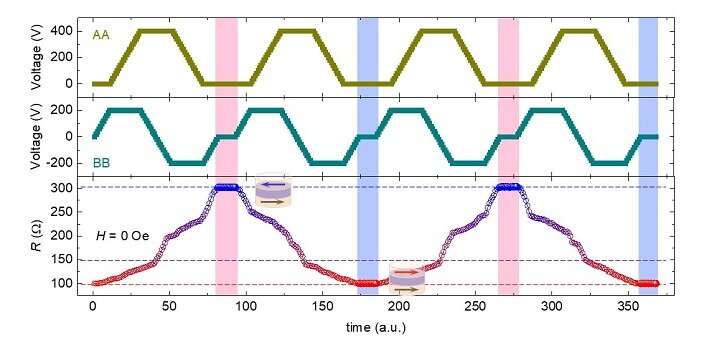A new spin on low-power data storage: Tiny ferromagnets with ultrathin insulating layers

The ability to control the magnetization of electrodes made from ferromagnets could help develop more energy-efficient devices for spintronic applications, including data storage technologies, wearable electronics and implantable medical devices.
Fueled by the demand for information storage technologies with increased capacity, miniature devices called magnetic tunnel junctions (MTJs) have emerged as a promising way to store large amounts of data.
MTJs consist of tiny ferromagnets separated by an ultrathin insulating layer. Their electrical resistance can be switched between low and high states—corresponding with the binary bits zero and one—and so can be used to store information in magnetoresistive random access memory and other spintronic devices.
Traditionally, this switching has used a magnetic field, a spin-orbit torque or a spin-transfer torque, which applies a high electric current density to the device that then dissipates large amounts of energy.
Now, Aitian Chen, KAUST colleagues and scientists from the National University of Defense Technology in China, have made MTJs on ferroelectric substrates. These can be controlled by voltage alone, resulting in a dramatic reduction in energy consumption.
"Integrating spintronics with multiferroics allows magnetic and electric properties of MTJs to be coupled and is a promising approach for the energy-efficient operation of MTJs," explains Chen.
To control the voltage of MTJs, the researchers used KAUST's advanced sputtering and lithography facilities first to deposit high-quality MTJ films onto the ferroelectric substrates. Next, they fabricated the devices using photolithography and ion milling.
By applying voltage to the ferroelectric substrate, the team could switch the magnetization configuration of MTJs between antiparallel and parallel states, which correspond with high- and low-electrical resistance, respectively.
Using pairs of electrodes on the ferroelectric substrate to generate a piezostrain, they were able to modulate the magnetization of the ferromagnetic layer via strain-mediated magnetoelectric coupling.
"Currently, we require two electrode pairs to achieve full control of MTJs, but the operation is very complicated. We are now looking to simplify the operation by using only one pair of electrodes," says Chen.
More information: Aitian Chen et al. Full voltage manipulation of the resistance of a magnetic tunnel junction, Science Advances (2019). DOI: 10.1126/sciadv.aay5141
Journal information: Science Advances





















